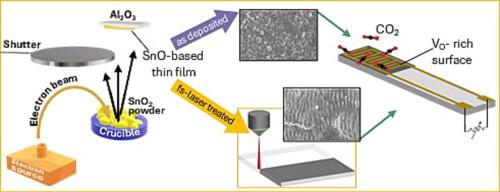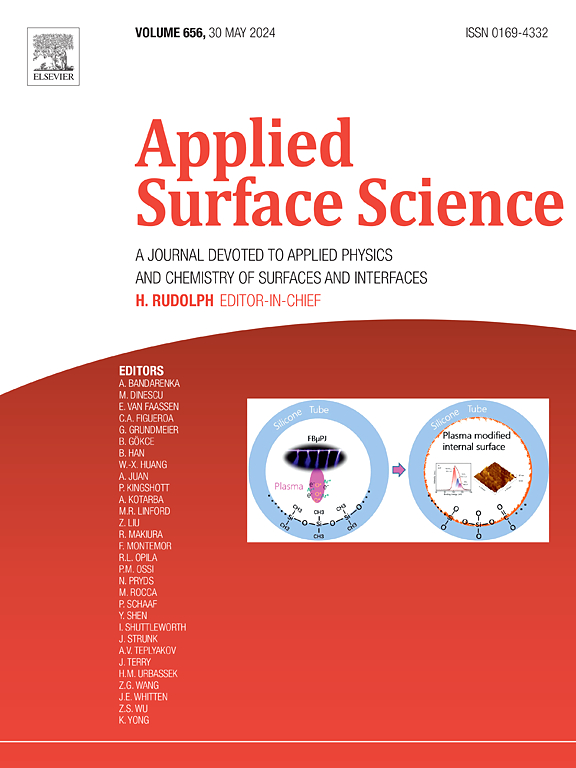用于室温下高效二氧化碳气体传感的二氧化硒基工程薄膜
IF 6.3
2区 材料科学
Q2 CHEMISTRY, PHYSICAL
引用次数: 0
摘要
通过电子束蒸发将基于氧化锡(SnO2)的薄膜沉积在氧化铝印刷电路板上,以制造在室温下工作的二氧化碳气体传感器。飞秒激光表面纳米挤压是一种优化关键气体灵敏度参数(包括表面粗糙度和晶粒尺寸)的新方法。拉曼光谱和 X 射线光电子能谱显示,敏感层由 1 µm 的氧化锡薄膜和非均一的二氧化锡上层组成。这些层之间的电子差异形成了一个原生的氧化锡-二氧化锡界面,形成了一个 p-n 结,从而提高了传感器的灵敏度。当二氧化碳浓度为 1000 至 2000 ppm 时,该传感器的传感响应为 7% 至 20%,当浓度为 5000 ppm 时,传感响应高达 40%。激光照射引入了周期性表面结构(∼ 800 nm),增加了粗糙度和气体传感活性位点的数量。虽然在灵敏度方面没有观察到明显改善,但经过缂丝激光处理的传感器表现出更高的稳定性和可重复性,这表明它有潜力成为室内空气质量应用领域的低能耗气体传感平台。本文章由计算机程序翻译,如有差异,请以英文原文为准。


Engineered SnO2-based thin films for efficient CO2 gas sensing at room temperature
Tin oxide (SnO2)-based thin films were deposited on alumina printed circuit boards via electron beam evaporation to fabricate CO2 gas sensors operating at room temperature. Femtosecond laser surface nanotexturing was applied as a novel approach to optimize key gas sensitivity parameters, including surface roughness and grain size. Raman and X-ray photoelectron spectroscopy revealed that the sensitive layer consists of a 1 µm SnO film with a non-stoichiometric SnO2 upper layer for the as-deposited film. The electronic disparity between these layers forms a native SnO-SnO2 interface, creating a p-n junction that enhances sensor sensitivity. This sensor shows a sensing response ranging from 7 % to 20 % for CO2 concentrations of 1000 to 2000 ppm, and up to 40 % at 5000 ppm. Laser irradiation introduced periodic surface structures (∼ 800 nm), increasing the roughness and the number of active sites for the gas sensing. Although no significant improvements were observed in terms of sensitivity, the fs-laser treated sensor exhibited enhanced stability and reproducibility, indicating its potential for low-energy consumption gas sensing platforms for indoor air quality applications.
求助全文
通过发布文献求助,成功后即可免费获取论文全文。
去求助
来源期刊

Applied Surface Science
工程技术-材料科学:膜
CiteScore
12.50
自引率
7.50%
发文量
3393
审稿时长
67 days
期刊介绍:
Applied Surface Science covers topics contributing to a better understanding of surfaces, interfaces, nanostructures and their applications. The journal is concerned with scientific research on the atomic and molecular level of material properties determined with specific surface analytical techniques and/or computational methods, as well as the processing of such structures.
 求助内容:
求助内容: 应助结果提醒方式:
应助结果提醒方式:


